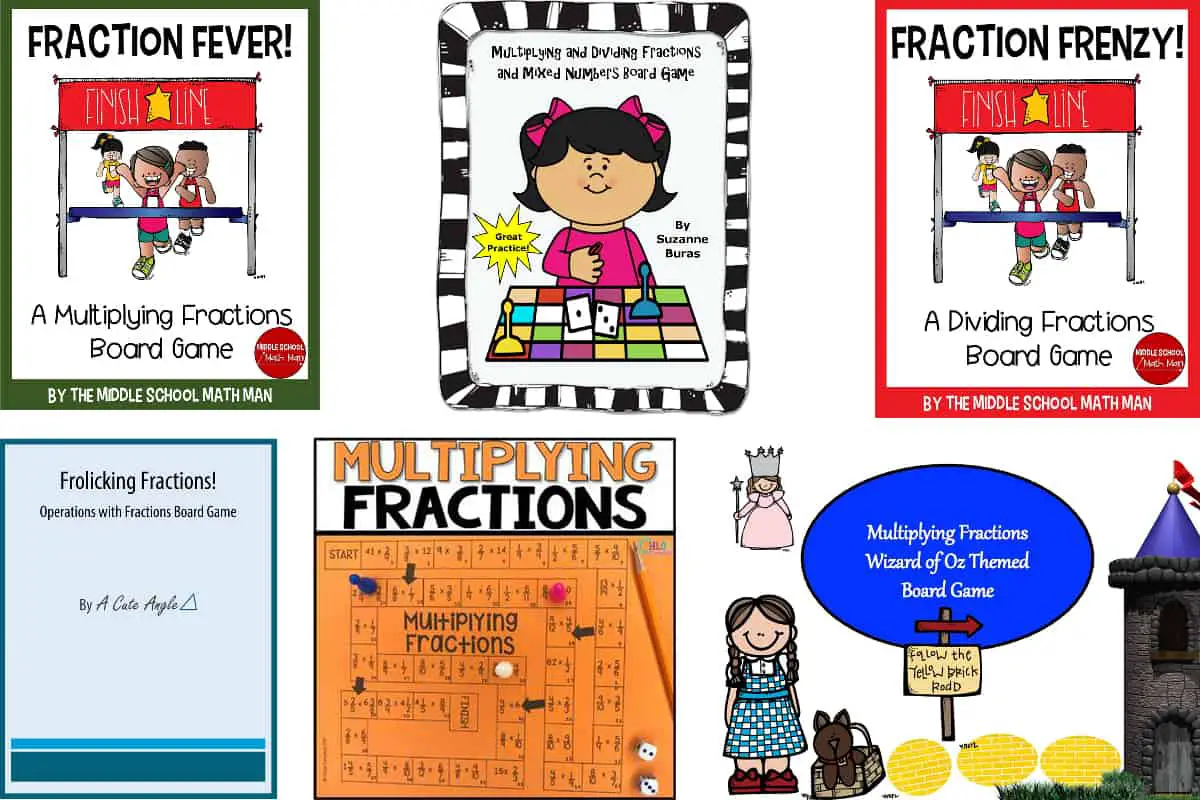This post contains affiliate links.
Children often confuse the steps for adding and subtracting fractions with the steps for multiplying and dividing fractions. What a mess! Thankfully, there are some printable fraction board games that make learning multiplying and dividing fractions fun.
I found 6 useful printable fraction board games for multiplying and/or dividing fractions. They are meant for small group classroom settings but can also be used at home. I highly recommend “Multiplying and Dividing Fractions and Mixed Numbers” by Suzanne Buras.
Printable Fraction Board Games Comparison Table
| Game | Grades | Players | Price | For | Rating |
|---|---|---|---|---|---|
| Multiplying Fractions – Wizard of Oz | 2-4 | 2‑4 | $ | Teachers | ★★★☆☆ |
| Multiplying and Dividing Fractions | 4-6 | 2‑4 | $ | Teachers | ★★★★☆ |
| Multiplying Fractions Board Game | 5 | 2‑4 | $ | Teachers Families | ★★★☆☆ |
| Fraction Frenzy! | 4-7 | 2‑5 | $ | Teachers | ★★★☆☆ |
| Fraction Fever! | 4-7 | 2‑5 | $ | Teachers | ★★★☆☆ |
| Frolicking Fractions! | 7-8 | 4 | $ | Teachers | ★★★☆☆ |
Printable Fraction Board Games for Primary/Elementary School
Multiplying Fractions Board Game – Wizard of Oz Theme (PowerPoint Maniac)
★★★☆☆
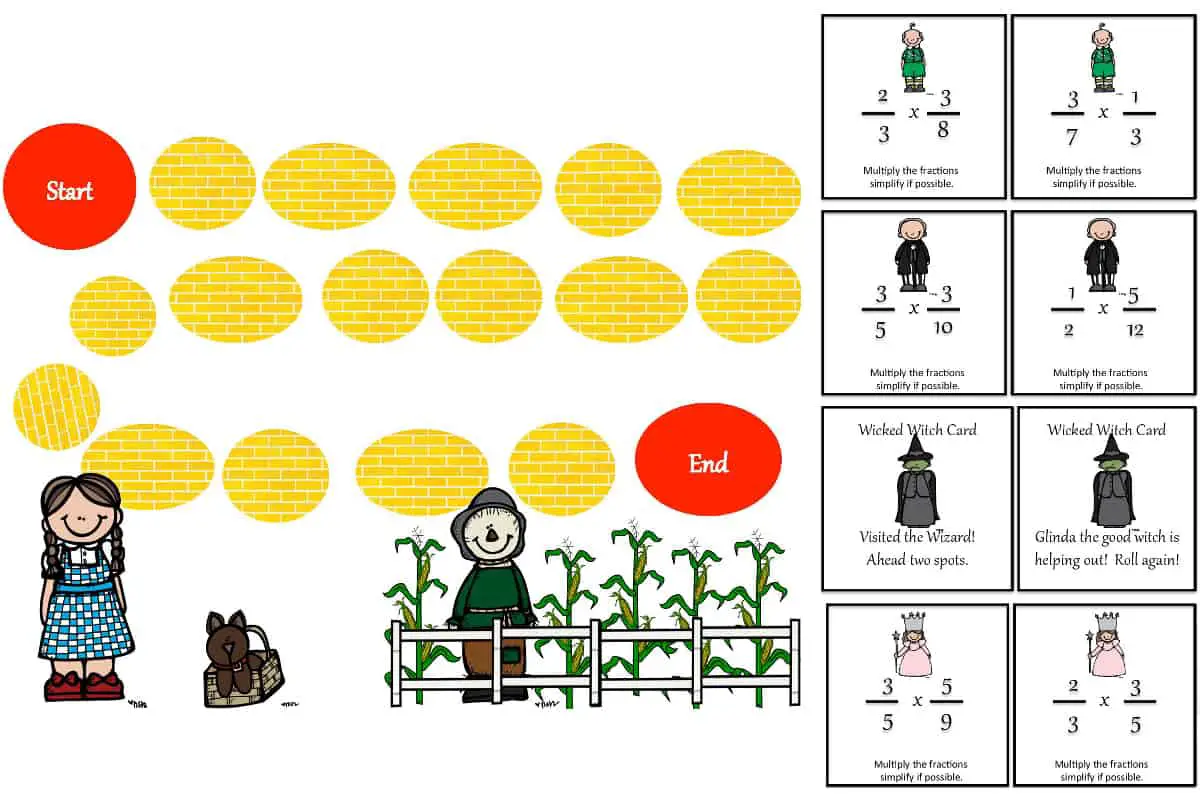
Players: 2-4 | Ages: 7-10 | CCS Grades: 2-4
This Wizard of Oz themed game has colorful and cute game card designs that would be appealing to younger children from about 7 to 9 years old. Teachers can use this game with small groups of more advanced children at grade 2 and 3 to teach them how to multiply proper fractions.
themed game has colorful and cute game card designs that would be appealing to younger children from about 7 to 9 years old. Teachers can use this game with small groups of more advanced children at grade 2 and 3 to teach them how to multiply proper fractions.
The game instructions are simple and demonstrate that this game can adequately engage the target age group. However, the game board has a short path and there are only 12 multiplying fractions questions. This means that the game will finish quickly although it may take younger children a bit longer than say a grade six child.
Multiplying and Dividing Fractions and Mixed Numbers (Suzanne Buras)
★★★★☆
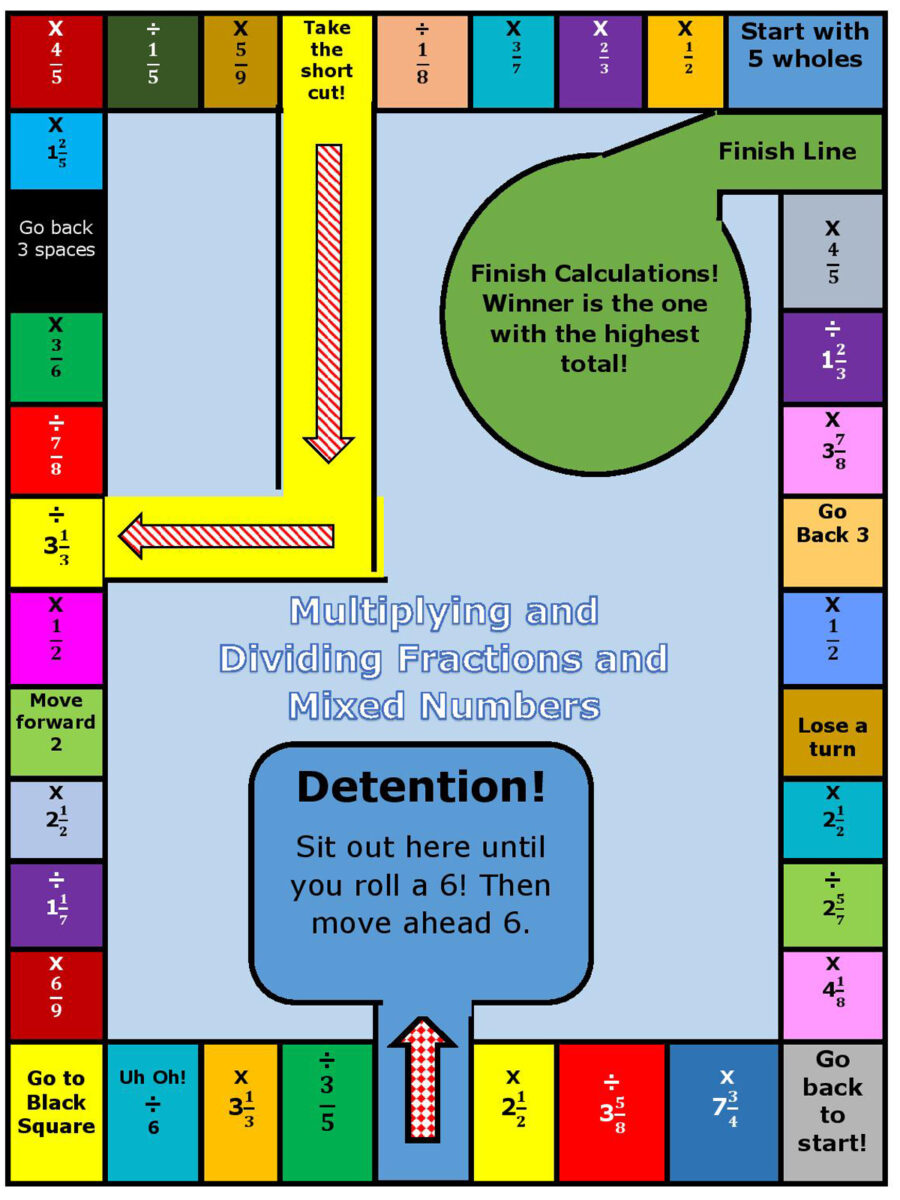
Players: 2-4 | Ages: 9-12 | CCSS Grades: 4-6
This printable fraction board game is exciting! It has a game board unlike the typical game board you’d see with other printable fraction board games. Instead, it’s multi-colored and filled with some fun traps such as “Detention! Sit out here until you roll a six.”
is exciting! It has a game board unlike the typical game board you’d see with other printable fraction board games. Instead, it’s multi-colored and filled with some fun traps such as “Detention! Sit out here until you roll a six.”
It’s a great game for reinforcing multiplying and dividing fractions and mixed numbers. These opportunities come in the form of random multiplication or division questions based on where the player lands on the board. Since the questions are random, it would be impossible to have an answer key.
There are even opportunities for students to practice adding fractions, subtracting fractions and simplifying fractions. Each player has a Running Total Score Card that is used to write the answer for each turn. The simplified answers are added together to give a new running total. The aim is to be the player with the highest running total. Teachers can collect these Running Total Score Cards at the end of class to track each student’s progress.
This game also encourages peer comparisons and discussion. A player can challenge the answer of another player. If this is done, all players have to solve the question and discuss their answers. The active player loses all points and returns to the “Start” position if the answer is incorrect. Therefore, students are going to be as careful as possible with the calculations.
One drawback to this game is that there is no set duration. It’s a game that could go far beyond the allotted class time. Therefore, teachers should be very deliberate about the timeframe in which the game should be completed. Additionally, teachers should have additional activities for more advanced students who will finish the game before the rest of the class.
Multiplying Fractions Board Game (Chloe Campbell)
★★★☆☆

Players: 2-4 | Ages: 10-11 | CCS Grade: 5
Chloe Campbell’s Multiplying Fractions Board Game is simple, yet effective. It has 41 multiplying fractions questions that cover multiplying proper fractions, multiplying whole numbers and proper fractions, and multiplying mixed numbers. Although the game board design doesn’t have some of the surprise elements found in other printable board games, it still gives players an opportunity to advance quickly using special arrows. If a player lands on a space where there is an arrow and solves the question correctly, he or she can then slide the game piece down the arrow to a much further position on the board.
Multiplying Fractions Board Game is simple, yet effective. It has 41 multiplying fractions questions that cover multiplying proper fractions, multiplying whole numbers and proper fractions, and multiplying mixed numbers. Although the game board design doesn’t have some of the surprise elements found in other printable board games, it still gives players an opportunity to advance quickly using special arrows. If a player lands on a space where there is an arrow and solves the question correctly, he or she can then slide the game piece down the arrow to a much further position on the board.
She suggests that this game is great for homework. However, teachers should use this approach cautiously. It will only work with parents who are supportive of providing guided instruction while playing the game rather than just giving the child the answers.
This game also has three different styles of answer recording sheets. It’s unclear about the rationale for this since each recording sheet has a space for the child to write his or her name. It would have been better to choose the sheet that gives each child ample space to record answers rather than have multiple.
Additionally, all the answers to the game board questions are on one sheet. This seems to be a common trend in many of the printable board games featured. However, structuring the answer sheet in this way means that one of the players won’t be able to benefit from the learning experience. This isn’t a problem though if the game is being played at home since the parent would be the person checking the answers.
Printable Fraction Board Games for Middle School
Fraction Frenzy: A Dividing Fractions Board Game (Middle School Math Man)
★★★☆☆
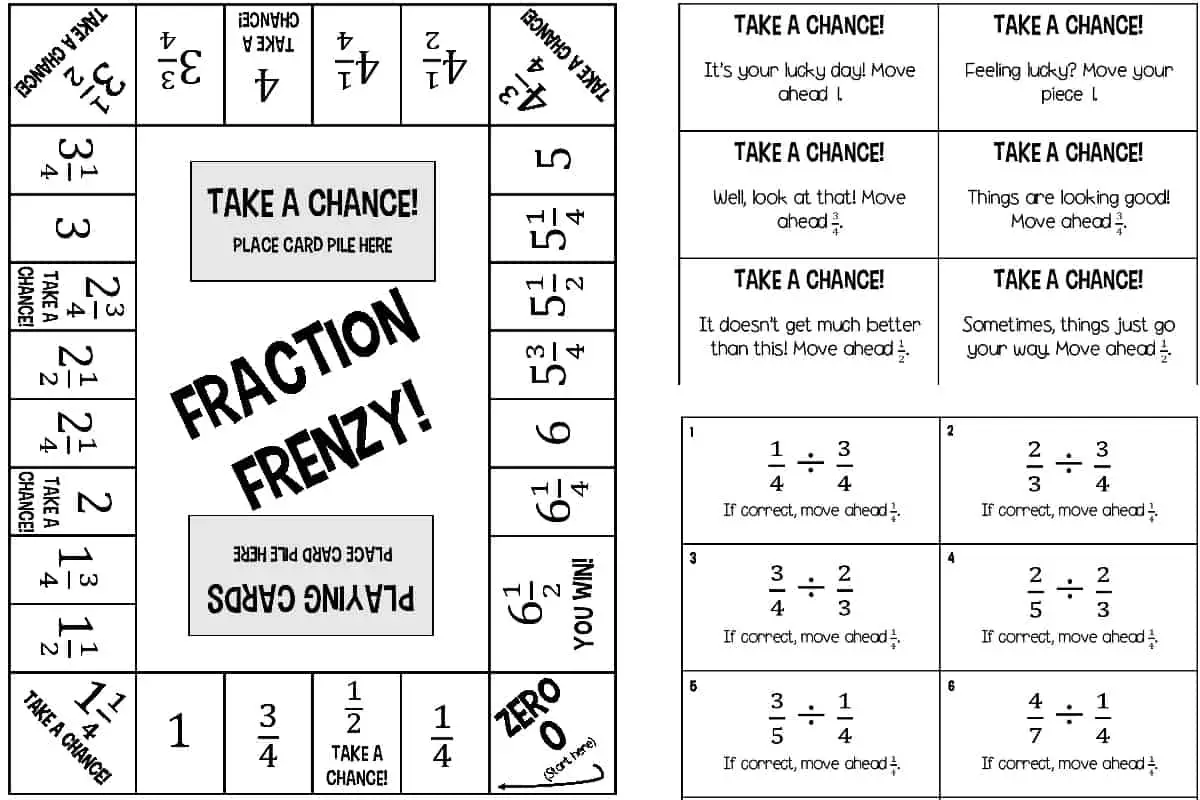
Players: 2-5 | Ages: 10-13 | CCS Grades: 4-7
Fraction Frenzy has an answer key. That’s a positive sign since teachers won’t have to worry about the cries for attention while each group works. However, how the answer key is presented poses a challenge since all the answers are on one sheet. Therefore, each group will need a player to verify answers who won’t be fully engaged in the learning experience.
has an answer key. That’s a positive sign since teachers won’t have to worry about the cries for attention while each group works. However, how the answer key is presented poses a challenge since all the answers are on one sheet. Therefore, each group will need a player to verify answers who won’t be fully engaged in the learning experience.
Another interesting feature of the game is the “Take a Chance” cards. These cards give players the opportunity to take advantage of movements around the board. However, some of these cards are a bit ambiguous. For instance, one of the cards says, “Well, look at that! Move ahead ¾.” It isn’t clear what this ¾ represents. Is it ¾ of the total spaces on the board or ¾ of the spaces on a particular side of the board where the player has landed?
The aim of the game is to be the first player to get 6 ½. Players don’t necessarily have to get to the 6 ½ position on the game board. Therefore, gameplay can end within about 10 minutes if all players are answering their questions correctly.
Fraction Fever! A Multiplying Fractions Board Game (Middle School Math Man)
★★★☆☆
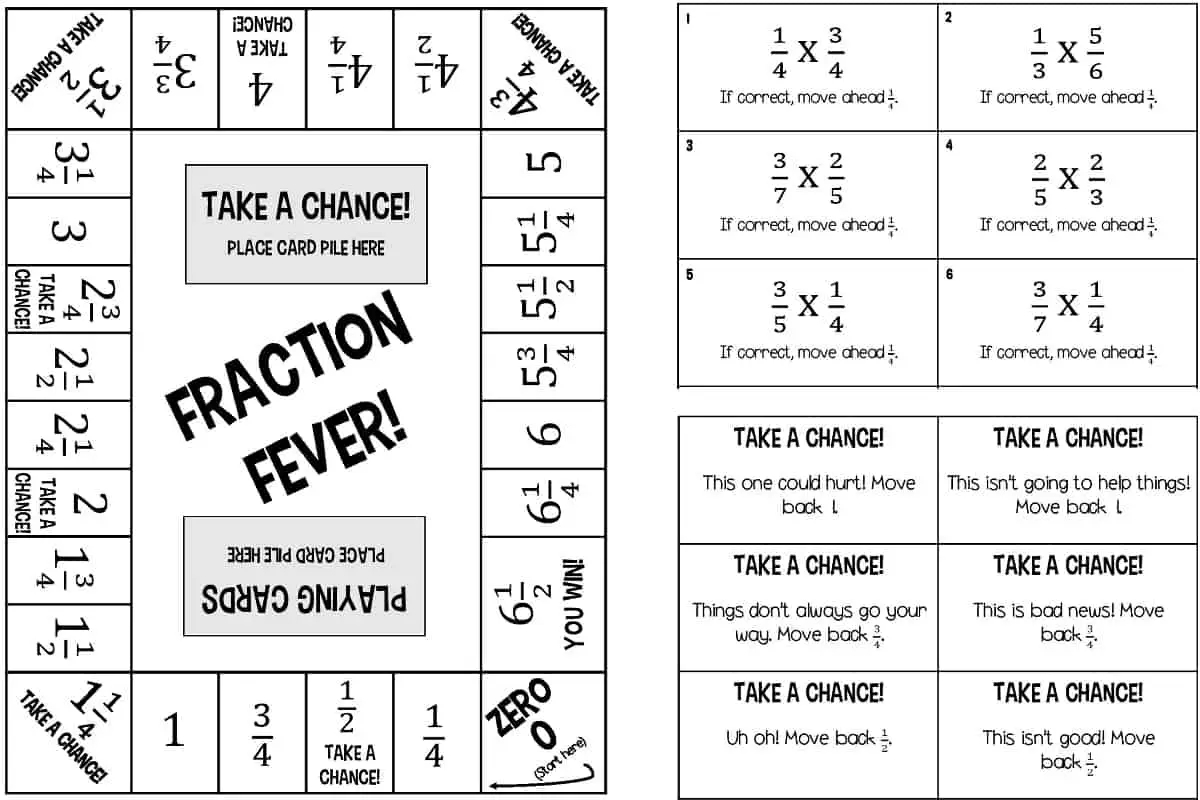
Players: 2-5 | Ages: 9-13 | CCS Grade: 4-7
Fraction Fever is like Fraction Frenzy and that’s no coincidence since they were created by the same author. The only difference between both games is that this game focuses on multiplying fractions while Fraction Frenzy focuses on dividing fractions. Teachers can purchase both games together to form a complete game set for revising multiplying and dividing fractions.
is like Fraction Frenzy and that’s no coincidence since they were created by the same author. The only difference between both games is that this game focuses on multiplying fractions while Fraction Frenzy focuses on dividing fractions. Teachers can purchase both games together to form a complete game set for revising multiplying and dividing fractions.
Both games have the same shortcomings:
- The answer key is on one sheet.
- Some of the Take a Chance cards are unclear.
Nevertheless, this game is a good resource for giving students additional practice with multiplying fractions and mixed numbers.
Frolicking Fractions! Operations with Fractions Board Game (A Cute Angle)
★★★☆☆

Players: 4 | Ages: 12-14 | CCS Grade: 7-8
Frolicking Fractions is a great game for reinforcing all four basic operations (addition, subtraction, multiplication and division) with fractions. It’s a game that can be modified to suit the topics that you want to cover. Players also get additional practice with integers since the game also includes negative fractions.
is a great game for reinforcing all four basic operations (addition, subtraction, multiplication and division) with fractions. It’s a game that can be modified to suit the topics that you want to cover. Players also get additional practice with integers since the game also includes negative fractions.
The game instructions encourage group collaboration and peer comparison. The active player should attempt the question created from the cards drawn. However, all players should also complete the question and verify the active player’s answer. The active player can only roll the dice if his or her answer is correct.
There isn’t an answer key because questions aren’t predetermined. Instead, questions are based on the fraction and operation cards that the players draw from the piles. This means that the teacher may need to provide some guidance while the game is being played.
Edudingo.com is a participant in the Amazon Services LLC Associates Program, an affiliate advertising program designed to provide a means for sites to earn advertising fees by advertising and linking to Amazon.com. We also participate in other affiliate programs which compensate us for referring traffic.

